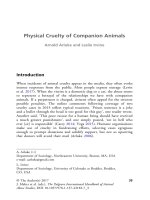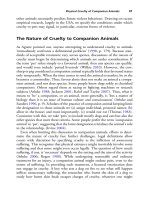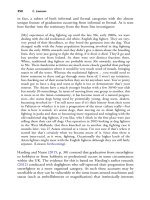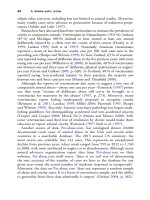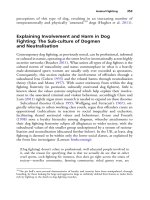The palgrave international handbook of a 191
Bạn đang xem bản rút gọn của tài liệu. Xem và tải ngay bản đầy đủ của tài liệu tại đây (26.91 KB, 1 trang )
184
N. Taylor and H. Fraser
thinking which leads to animals being cast as inferior to humans. They are
mere animals to our cultured humanity, barbarians to our civility and nature to
our culture. This gives humans license to see themselves at the top of the food
chain, presiding over all other animals who are enslaved and objectified.
Ecofeminist scholars have long chronicled the damage that has arisen from
such binary worldviews, and it is a damage that affects both other species and
groups of disenfranchised humans (for example, Gruen 1993). It is an outlook
that justifies the oppression of those considered to be other and, to many, it is
the foundation of multiple harms. As Will Tuttle (2014, pp. 20–21) argues,
. . . the underlying mentality causing our problems is injected into us via our
cultural programming, and that it is not innate. It’s animal agriculture. Besides
being the driving force behind global climate disruption, rainforest destruction,
air and water pollution, soil erosion, desertification, collapse of ocean ecosystems, species extinction, world hunger, chronic disease, economic inequality,
and war, animal agriculture is also the driving force in creating the inner
mentality that drives conflict, injustice, competition, and the various forms
of social injustice that plague our world. . . . we are injected with a cultural
program of violence toward defenceless and enslaved animals, and the ripples of
that radiate as exclusivism, speciesism, and the many forms of separateness and
entitlement that we see around us.
Here Tuttle points to the ways in which the AIC is embroiled within, and
often creates, systems of oppression that damage humans, animals and the
environment. Recognising these links takes some courage as it involves
stepping outside the usual, human preoccupation. Understanding the ideological underpinnings of the AIC is crucial to understanding how it is that
the systematic and publicly endorsed slaughter of billions of animals can be
accepted by the vast majority of people. In particular, it sheds light on
understanding this acceptance by people who are not otherwise particularly
violent or cruel; people who may often demonstrate compassion for others,
including other animals, such as their companion dogs or cats. The AIC
helps us to understand why animal abuse is accepted as normative.
Explanations
When many people in the West consider themselves to be ‘animal lovers’, it
may seem contentious to claim that slaughterhouse abuse is a legitimate
category of abuse and that animal abuse is normative. Similarly, it may seem
